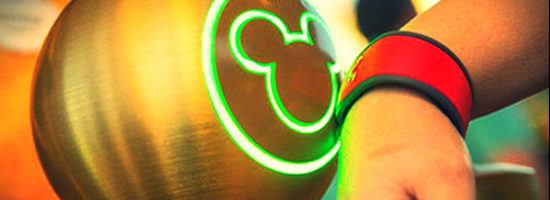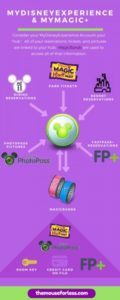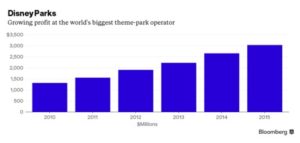MYMAGIC+: DISNEY’S BIG BLUNDER?

Disney spent $1B on MYMAGIC+ – was it worth it? Time will tell.
The digital revolution has become a game changer for Disney theme parks with increasing guest flow issues, seasonal demand, and unpredictable wait times.
With Disney Parks’ growing profit, they must keep up with competitor’s investments in technology and look to keep guests returning for more. Guests look to Disney to have a premiere family friendly vacation; with this guest promise in mind Disney must use digital technology to increase guest satisfaction and create memorable customized guest experiences. For Disney, the continued advancement of digital technology allows them to unleash a huge collection of information and communications data to specific demographics.
Launched in 2014, MyMagic+ was Disney’s $1B investment for the digital future of Walt Disney World. MyMagic+ (available to Walt Disney World guests) consists of a My Disney Experience website, smart-phone app, RFID band called a MagicBand, and FastPass+ system allowing for a flexible guest experience [1]. All the facets of this development are aligned with guests using the MagicBand to purchase merchandise, food, park tickets, fast pass tickets, and hotel rooms by tapping your band to a scanner with a PIN code (no cash or hotel cards needed!). The app or website allows you to link your MagicBand to your customized Disney experience through pre-planning, with more than 25% of guests choosing to plan their visit ahead of time [2]. Just after six months of MyMagic+, per capita spending at Walt Disney World, “Was up 4% on higher ticket prices, food and beverage, and merchandise spending. Per room spending in hotels was up 3% and occupancy was up 6 percentage points to 86%” [2]. The bet seemed to be paying off.
The pre-planning portion of the Disney experience is integral. Through driving the guest to plan their dining options and choose what rides they want fast pass tickets for, Disney can control the guest experience. How? By controlling guest flow through fast pass tickets and thereby controlling the number of guests they would like to have in certain areas during the day.

But couldn’t all of this been solved with just a smart phone app? Why spend $1B on the MagicBand technology?
The problem with technology that takes years to build like MyMagic+ is the fast pace of the digital-tech industry. Shanghai Disneyland which opened June 2016 did not roll out MyMagic+, instead choosing to keep ticket, merchandise, and personal experience sales all on a smart phone application [5]. Douglas Quinby, VP at Phocuswright, said that, “When Disney was first making their investment in Orlando, the mobile revolution was still at a very early stage. Nobody knew how all these technologies were going to shake out” [5]. Perhaps the $1B bet Disney took was premature. In December 2015, Bob Iger, CEO of Disney, stated that in Shanghai, “The consumer will be able to buy their tickets, use their mobile devices in far more advanced, compelling ways than any other place from a theme park perspective” [5]. By not rolling out the Magic Bands in Shanghai, Disney will save on the cost of creating the RFID bands and shipping them to guests. Is mobile the best strategy as it requires less infrastructure?
Disney has invested in patents that have yet to see the light of day. Currently, they hold a patent on a recognition system that scans visitors’ feet [4]. This technology works when a guest walks onto a sensor that retrieves information regarding the guest’s foot to create a customized guest experience [4]. This technology would associate the guest’s data (such as their name) and their foot together to trigger specialized experiences for that guest [4]. Is this a technology (which requires significant infrastructure) worth the returns in guest satisfaction and increased guest spending?
The inherent risks as Disney moves forward is what digital patents to explore further. Disney will need to find ways to mine through their data on guests to ensure the optimal experience with ideal traffic flow and flexible daily results. As parks become more crowded and guests expect magical experiences, Disney must look towards developing patents that allow its cast to engage with guests in a meaningful and genuine manner while ensuring that increased crowds do not hinder the personalized approach they are known for.
(797 words without citations)
Citations
[1] Tom Staggs, “Taking the Disney Guest Experience to the Next Level,” Disney Parks(blog), Disney Parks, January 7,2013, https://disneyparks.disney.go.com/blog/2013/01/taking-the-disney-guest-experience-to-the-next-level/, accessed November 2016.
[2] Source: Boardroom Insiders Profiles, “Tilak Mandadi – SVP and CIO, Walt Disney Parks and Resort, Walt Disney Company,” Boardroom Insiders, Inc., 2016, ABI/INFORM via ProQuest, accessed November 2016.
[3] Source: Biometric system; From facial recognition on Disney cruises to iris reading at borders, high-tech is taking over travel, via Factiva, accessed November 2016.
[4] Source: Disney wants your best foot forward; New technology lets your toes be the company’s guide to create a more customized experience., via Factiva, accessed November 2016.
[5] Christopher Palmeri, “Why Disney Won’t Be Taking Magic Wristbands to Its Chinese Park,” Bloomberg, January 10,2016, http://www.bloomberg.com/news/articles/2016-01-10/why-disney-won-t-be-taking-magic-wristbands-to-its-chinese-park ,accessed November 2016.
[6] Jocelyn, “MAGICAL & CONVENIENT TECHNOLOGY IN USE AT WALT DISNEY WORLD,” Mouse for Less, July 19,2016, http://www.themouseforless.com/blog_world/2016/07/mymagic-technology-walt-disney-world/,accessed November 2016.





It’s really interesting to think that Disney has invested so much in trying to come up with new technologies to stay competitive among other theme parks and other recreational experiences. It seems that they may have been a little premature with their strategies, and taken a scattershot approach by buying up a lot of patents and waiting to see which one will be the most successful. You ask, “Is mobile the best strategy as it requires less infrastructure?” I think yes. Having to ship a separate RFID band to customers and making sure they return it seems like an added hassle and infrastructure investments. It’s interesting because Universal Orlando recently launched a mobile app that can help you buy tickets, get real-time wait times for rides, etc. (https://www.innovationleader.com/universal-orlando-exec-on-deploying-tech-to-theme-parks/) They claim to take a more measured, systematic approach to implementing new technologies. So while Disney may be a first mover when it comes to implementing new technology, will consumers appreciate it?
While in some ways the RFID bands can make for a more seamless consumer experience, in reality it’s the concessionaire who often wins. Some music festivals in the US have begun to use RFID bands, but instead of just linking your credit card directly, you have to pre-load money on the band. This has lead to a 20% increase in on-site payments: https://www.eventbrite.com/blog/ds00-cashless-are-rfid-payments-right-for-your-event/ but there’s a treat of consumer backlash. I worked with Electric Zoo on their NYC festival which required fans to put money on their bands in “E Zoo bucks” to buy concessions, but there was a confusing conversion rate of dollars to E Zoo bucks to make it look like consumers were spending less than they actually did. They got a lot of bad press from consumers who thought the system was not transparent so they ended up discontinuing the program the next year.
Whether it’s a mobile app or RFID bands, I think it would be interesting for concessionaires to allow consumers to set limits on what they would like to spend so customers have more transparency and control over their purchases.
While I agree with Roanna that mobile probably makes more sense from an infrastructure investment perspective, as a consumer, I selfishly would like to see MyMagic+ continue as I’m personally a huge fan. I was at the Orlando park when the program was first rolled out and the experience of using the MagicBand was, for lack of a better word, magical. I take your point regarding the pace of digital tech innovation, but I would argue that one centralized smartphone app was the right decision for Shanghai largely because mainland Chinese consumers are much more dependent on mobile day to day and have come to expect mobile as the primary mode of transacting, which is not necessarily the case elsewhere.